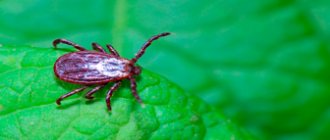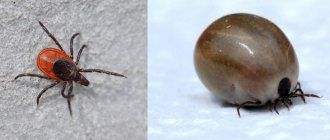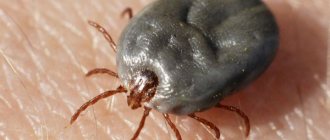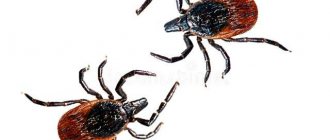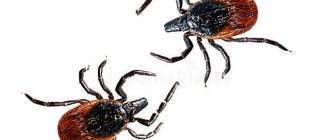Where to look?
Ticks live in the grass (and not on birch trees) and cling to dogs from blades of grass. They wait for their prey, spreading their tenacious paws in order to grab onto the animal running past in time. Then the parasite crawls upward, looking for a “softer” place to bite into.
- Stomach;
- Armpits;
- Knee and elbow bends;
- Inner thigh;
- Groin area;
- The space behind the ears and the ears themselves;
- Mucous membranes - mites can be found in the oral cavity on the gums and even on the genitals.
How to remove a tick?
There are many methods for removing ticks, but they are all similar. The main movement is to rotate the tick around its axis. How can you remove a tick from a dog?
Tick remover.
A special device that looks like a spatula with a curved forked plate at the end. This is perhaps the best and most reliable way. The tick is picked up with this device and rotated around its axis 3-4 times. After that, pulling it out is not difficult. It is not difficult to remove a tick using a twister, and there is no risk of leaving the proboscis in the wound.
Tweezers.
Grasp the tick firmly with tweezers as close to the dog's skin as possible. And scroll around its axis. Voila - the parasite has been removed. It sounds simple, and for an experienced person, a veterinarian, for example, removing a tick this way is not a problem. But the average owner runs the risk of leaving the proboscis in the wound.
Thread.
Make a loop of thick thread (a thin one can “cut” the tick when pulled out), throw it over the tick and... spin the parasite around its axis. The method is quite controversial, because it is not always possible to remove an uninvited guest the first time. It is always better to purchase a screwdriver and use it to remove the parasite.
After removing the tick from the dog, disinfect the wound with an antiseptic in one way or another!
What to do if part of the tick remains in the dog’s skin?
To begin with, calm down. If the parasite is removed correctly, nothing will remain in the dog, but if done incorrectly, there is a risk of leaving the proboscis in the wound. If this happens, it's okay. It's unpleasant, but not fatal! This is the dead part of the tick’s body and can no longer transmit blood-parasitic diseases to the dog’s body.
The body is designed in such a way that it does not tolerate anything foreign. The bite site will become inflamed, the wound will open, and the tick's proboscis will come out on its own. If you see a pimple where a tick was sitting, just treat it with an antiseptic and observe. Are you very worried? Contact a veterinary clinic.
What not to do
The Internet is full of bad advice. Some people are especially surprised - as soon as this comes to mind? Some people advise burning a tick with celandine juice, others – placing a copper coin on the full moon... It is clear that esoteric and folk methods are unlikely to work, so let’s consider myths that are closer to reality.
Let's find out!
1.
The most common myth is to pour oil on a tick and then it will come out on its own. No, it won’t come out, it can even go deeper and more actively secrete salivary fluid - namely, it contains protozoa, which are so dangerous for the dog. In any case, you will have to remove the tick yourself. In addition, the fact that the oil gets into the wound that the parasite will leave behind is not very good.
2.
Covering a tick with nail polish is also a dubious method. Yes, the tick can die, but you still have to pull it out yourself. In addition, local irritation and inflammation of the skin due to the chemical composition of the varnish in dogs has not been canceled.
3.
It's the same with gasoline. No less dubious method! It's better not to take risks. Remember about allergies and skin irritation?
4.
When removing a tick, do not pull sharply, trying to tear the tick away from the dog. Firstly, it’s unlikely to work, and secondly, if it does work, then the probability of leaving a proboscis in the dog is quite high (although there’s nothing wrong with that).
After all, there are simpler ways - why take extra risks?
The tick has been eliminated. What's next?
If your dog is treated for ticks (for example, with a Simparika tablet) on time and in accordance with its weight, then simply monitor the animal for 10-14 days. You can have a tick tested, but the likelihood of your dog becoming infected is minimal. If the animal is not protected in any way, then in addition to observation, it is better to submit the tick for examination to a veterinary laboratory. There the parasite will be checked for hemoparasitic diseases and a conclusion will be issued.
Based on the results, your veterinarian will draw up a further treatment and prevention plan. It is important to understand that the presence of pathogens of vector-borne diseases in a tick does not mean that the dog has definitely become infected.
Most diseases are not transmitted to the wound immediately, but 12-48 hours after the bite (except for ehrlichiosis, which is transmitted much earlier). And if you removed the tick earlier than this period, then infection is unlikely.
But in the case where the parasite could not be detected immediately, and it was only possible to get it out 2-3 days after the bite or later, in this case, a positive laboratory conclusion about the presence of blood-parasitic diseases in the tick may be a reason to contact a veterinary clinic before the dog appears the first clinical signs of the disease.
Current tips and recommendations. Modern tendencies
The only effective protection for an animal is treatment with special preparations containing so-called acaricides. Prevention products are available in the form of drops, sprays and aerosols. You can even purchase special tick-repellent collars.
For example, subcutaneous mites in dogs will rarely manifest themselves if they were treated with Advantix or used the Foresto antiparasitic collar. The good news is that all types of ticks are sensitive to these products, and the drugs last quite long.
For example, it is enough to spray a few drops of Advantix onto the animal’s withers once a month. The effectiveness of the drug is from 98.5 to one hundred percent; it is directed not only against ticks, but also against other blood-sucking creatures - mosquitoes, flies, fleas. Foresto is effective for eight months. In addition, this collar is water-resistant, so it will be very useful if you and your dog are vacationing near any body of water.
When purchasing a product, it is very important to check its expiration date and the integrity of the packaging. Otherwise, it may turn out that you are confident that you have protected your pet from ticks, but in fact the drug will be useless.
By the way, it can cause signs of allergies in some animals, but this happens very rarely.
What is piroplasmosis and how to understand that your dog is sick
Piroplasmosis (also known as babesiosis) is a hemoparasitic disease caused by the protozoa Babesia canis or Babesia Gipsoni. A dog can become infected after a tick bite - along with saliva, the tick penetrates the dog's bloodstream and infects red blood cells - red blood cells that carry oxygen.
- Lethargy, apathy, refusal to eat;
- Fever (normal dog temperature is 37.5 – 39.0°C).
- Yellowness of the mucous membranes, sclera and skin;
- Urine is deep orange or red in color.
If any of these symptoms occur, visit your veterinarian immediately! Without treatment, piroplasmosis is fatal!
Prevention
The basis of prevention is timely treatment and examination of the dog after each walk. For treatment against external parasites, the most effective modern means are tablets:
Nexgard
Bravecto
Simparica
Drops on the withers are also effective:
Advantix
Frontline
Collars are not very effective and can only be used in combination with other drugs.
What can a dog become infected with from a tick besides piroplasmosis?
The most common disease that ticks carry is piroplasmosis. But besides it, there are others. For example, ehrlichiosis.
For example - ehrlichiosis
. Infection also occurs through the saliva of the tick. The danger of ehrlichiosis is that it can occur in a chronic form for years, gradually affecting the dog’s body more and more. It is difficult to detect the symptoms on your own; they are very vague.
What you should be wary of:
- Arthritis – inflammation of the joints;
- Enlarged lymph nodes;
- Periodic increase in temperature;
- Apathy, lethargy, loss of appetite;
- Blood clotting disorder – even from a minor wound the bleeding does not stop for a long time.
It is precisely such infections that are difficult to notice that are the reason to submit the tick to a laboratory for analysis.
Anaplasmosis (infectious thrombocytopenia) is also a disease transmitted by ticks.
The causative agent of anaplasmosis is the protozoan Anaplasma phagocytophillum, as well as Babesia, they live in the salivary glands of the tick and are transmitted to the dog through a bite.
If piroplasmosis affects red blood cells, then the target of anaplasma is platelets. Accordingly, the dog develops problems with blood clotting.
Symptoms:
- The appearance of bruises “out of nowhere”;
- Urine is red in color;
- Fever;
- Weakness of the hind limbs;
- Nausea, vomiting;
- Diarrhea;
- Enlarged lymph nodes.
Any of these symptoms is a reason to urgently contact a veterinary clinic for help. Delay can be deadly - anaplasmosis occurs both in a delayed form and in an acute (platelet) form.
There are many blood parasitic diseases, but their symptoms are generally similar. Therefore, if there is any deviation from the norm in the dog’s well-being, seek help from a veterinary clinic. By the way, dogs do not get tick-borne encephalitis. This is an exclusively “human” infection.
Briefly about the main thing
- Ticks are dangerous pests that can carry diseases: piroplasmosis, borreliosis, ehrlichiosis and many others.
- At the first symptoms of illness after a bite, contact your veterinarian immediately. Even if it's just loss of appetite or depression.
- Inspect your pet yourself after each walk, especially the face, paws, belly and groin area.
- Follow the pest removal algorithm and don’t forget about your safety - wear gloves.
- You should not pour oil or other liquids on the tick so that “it will die and fall off on its own.” This does not work.
- After removal, be sure to take the little scoundrel to the laboratory.
- Treat your pet for external parasites in a timely manner.
Have we answered your question fully enough? If not, post your question in the comments below and our veterinarian will answer it.
Did you like the article? Share it with your friends on social media. networks. This will help them get useful information and support our project.
Why Simparica?
Many people are surprised - how can a tablet save a dog from a tick? It's a pill, it can't affect the skin. How can it! The active ingredient of Simparica, sarolaner, is absorbed from the stomach and distributed through the bloodstream throughout the body. The tablet begins to work within 3 hours after use, and reaches the maximum degree of protection against ticks after 12 hours.
The mechanism of action of Simparika is such that after a tick bite, the active substance affects the nervous system of the parasite, and it dies before the hemoparasites have time to penetrate the animal’s bloodstream. At the same time, the dog’s body is structured differently and Simparika does not have a negative effect on the nervous system and the functioning of the animal’s internal organs.
Causes of problems, which animals are more susceptible
Unfortunately, the causes of problems associated with tick bites are objective, predetermined by nature itself. To a lesser extent, they apply to “urban” animals that are walked in parks and squares - where preventive treatment is usually carried out several times during the “tick season”. For our smaller brothers, who live with their owners in villages and dachas, the risk of a tick bite increases many times over.
Puppies are especially susceptible to attacks from this insidious enemy. Their delicate skin and fur, which is not as thick as that of adults, make them defenseless.
What to do? Folk remedies for prevention are ineffective, however, according to experienced dog breeders, it is useful to give your four-legged pets a “wash” from time to time using tar soap and wormwood decoction. Strong odors can deceive and disorient the tick for some time.
Light overalls for walking can be used as protective equipment for a dog. It is also necessary to protect pets from contact with yard dogs, which are constantly at risk.


